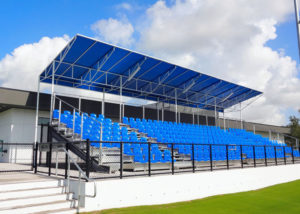 Unique and dynamic fabric canopies provide year-round shade and weather protection.
Unique and dynamic fabric canopies provide year-round shade and weather protection.
By Jake Kulju
As soccer gains in popularity across the United States, so does spectatorship. Lynn University of Boca Raton, Fla., has such a dedicated soccer fan base that they invested in large fabric canopies to shelter their spectators at their new soccer stadium.
The university wanted to provide covered weather protection for the Bobby Campbell Soccer Stadium. The new facility was designed as a soccer and lacrosse stadium for year-round use. The university was interested in a refreshing alternative to typical collegiate stadium design, and decided to pursue a fabric architecture application to create something unique and dynamic that would provide weather protection and shading for all spectators.
“The client wanted the canopies to be modern and make an architectural statement,” says Mike Reilly, sales associate at Miami Awning, Miami, Fla. The company’s designer, Ted Linze, says the university wanted to steer clear of metal roofing, which it had tried in the past. “They already had metal bleachers and wanted something that wasn’t very metallic looking,” he says. “The client also originally wanted virtually flat canopies. In order to shed water properly, we explained that fabrics have to have some pitch to them, especially if they are non-porous. We ended up making changes to the design that the client was happy with and met our engineering requirements.
The fabric
Fabric for the stadium project was carefully chosen for its weatherability, especially for its performance in UV rays and wind. Two large 66-foot by 2-inch by 15-foot by 3-inch panels of Coastline Plus®, a vinyl laminated on a weft insertion scrim base of high tenacity filament polyester, manufactured by Herculite Products Inc., Emigsville, Pa., was selected by the company and the client.
“Coastline Plus is one of the main fabrics we use, mostly because we are comfortable with how it performs in our climate,” says Mike Reilly, owner of Miami Awning. “It’s our go-to fabric because of its workability and waterproofing. It’s a vinyl laminated Dacron fabric that comes in a variety of colors.”
The PVC fabric is fade and shrink resistant and comes with a 5-year warranty from the date of installation. Its Rain Kleen® topcoat repels mildew and other stains. Coastline Plus is a fire-retardant awning fabric that meets the strict California State Fire Marshall requirements.
“The color also played a large role in [the selection of the fabric],” Linze says. “They needed something that matched their logo.”
Installation
The installation crew was not allowed on the field in front of the bleachers, which made the erection of the frame and installation of the fabric panels a unique challenge.
“The field had just been planted and was already in place and growing,” Reilly says, “and nobody was allowed to even step on the field. We had to lift the panels over the building from behind with a crane and set them on top of the columns, which we had measured precisely to make sure they fit right in.”
Columns were set in large footings at the base of the seating area. The frames, built with Sch. 40 galvanized steel pipe, were assembled in the shop and cut into two pieces for transportation. The crew then welded the frames together on site before lifting them with the crane for installation. “We selected the thickness of the steel pipe based on wind loads we needed to meet for hurricanes,” Reilly says. “We built the frame so that it could be removed in the event of a hurricane.”
Installation of the fabric panels required special scissor lifts that could fit on the narrow walkway in front of the seating area without touching the freshly seeded field. “We used the smaller scissor lifts to stretch out the fabric along the front edge of the frame while we laced it around the perimeter,” Linze says.
The eight-person Miami Awning crew hand tightened the panels to ¾-inch lace rails welded to the frames with No. 4 Zenith white braided rope. “Grommets were sewn into the border of the panels every 6 to 7 inches,” Linze says, “and we laced around the perimeter because the university mainly wanted the canopies for shade more than water protection.”
Fabric architecture helped turn the stadium into a more welcoming and attractive space. The client was very pleased with the outcome of the project and now uses the stadium for events throughout the year.
Jake Kulju, a frequent contributor to Fabric Architecture, is a freelance writer from Minneapolis, Minn.
Project data
Client: Lynn University, Boca Raton, Fla.
Design, fabrication, installation, project management: Miami Awning Co.
Architect: Gensler Architectural Firm
Fabric: Coastline Plus by Herculite Products Inc.
 TEXTILES.ORG
TEXTILES.ORG


